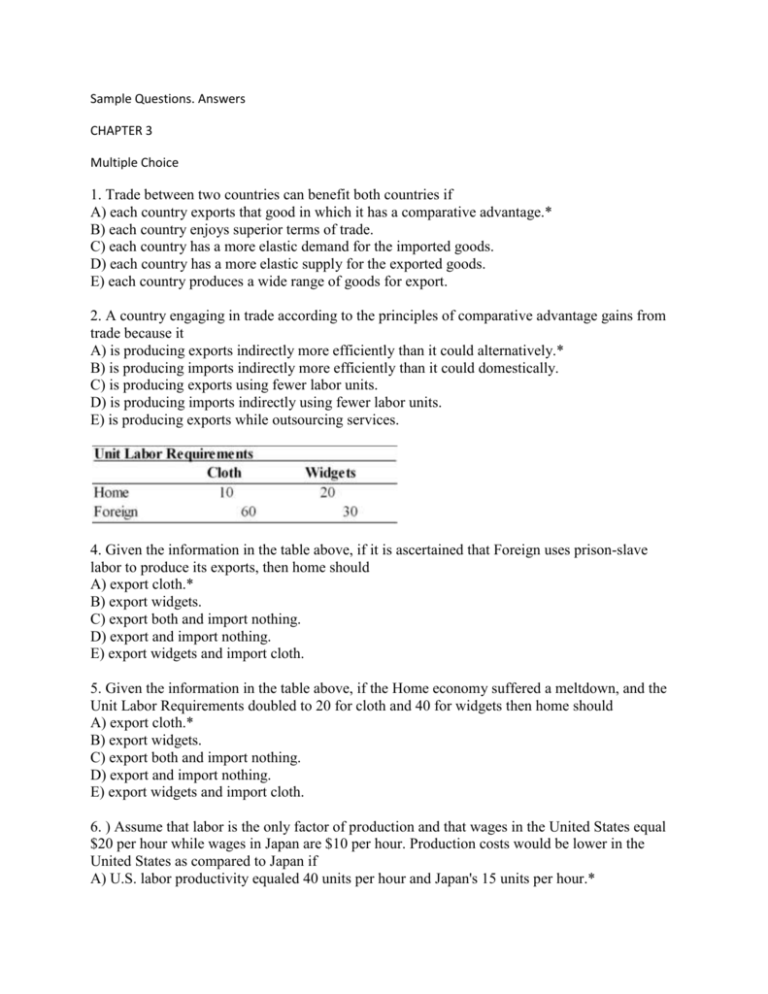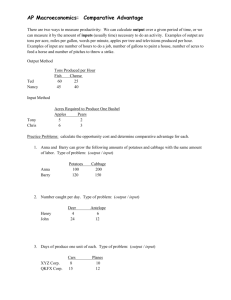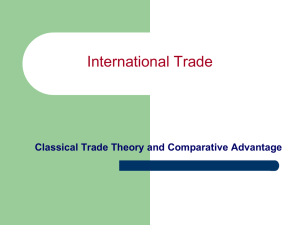CHAPTER 3 Answers
advertisement

Sample Questions. Answers CHAPTER 3 Multiple Choice 1. Trade between two countries can benefit both countries if A) each country exports that good in which it has a comparative advantage.* B) each country enjoys superior terms of trade. C) each country has a more elastic demand for the imported goods. D) each country has a more elastic supply for the exported goods. E) each country produces a wide range of goods for export. 2. A country engaging in trade according to the principles of comparative advantage gains from trade because it A) is producing exports indirectly more efficiently than it could alternatively.* B) is producing imports indirectly more efficiently than it could domestically. C) is producing exports using fewer labor units. D) is producing imports indirectly using fewer labor units. E) is producing exports while outsourcing services. 4. Given the information in the table above, if it is ascertained that Foreign uses prison-slave labor to produce its exports, then home should A) export cloth.* B) export widgets. C) export both and import nothing. D) export and import nothing. E) export widgets and import cloth. 5. Given the information in the table above, if the Home economy suffered a meltdown, and the Unit Labor Requirements doubled to 20 for cloth and 40 for widgets then home should A) export cloth.* B) export widgets. C) export both and import nothing. D) export and import nothing. E) export widgets and import cloth. 6. ) Assume that labor is the only factor of production and that wages in the United States equal $20 per hour while wages in Japan are $10 per hour. Production costs would be lower in the United States as compared to Japan if A) U.S. labor productivity equaled 40 units per hour and Japan's 15 units per hour.* B) U.S. labor productivity equaled 30 units per hour and Japan's 20 units per hour. C) U.S. labor productivity equaled 20 units per hour and Japan's 30 units per hour. D) U.S. labor productivity equaled 15 units per hour and Japan's 25 units per hour. E) U.S. labor productivity equaled 15 units per hour and Japan's 40 units per hour. 7. Suppose the United states production possibility frontier was flatter to the widget axis, whereas Germany's was flatter to the butter axis. We now learn that the German wage doubles, but U.S. wages do not change at all. We now know that A) the United States has no comparative advantage. B) Germany has a comparative advantage in butter.* C) the United States has a comparative advantage in butter. D) Not enough information is given. E) Germany gains a comparative advantage in widgets. 8. Which of the following has been confirmed by empirical tests of the Ricardian model? A) All predictions of the model for a multi-product, multi-country world are highly unrealistic. B) The existence of nontraded goods results in a high degree of specialization among countries. C) International trade has no impact on income distribution. D) The unimportance of economies of scale as a cause of trade. E) Companies tend to export goods in which they have a relatively high level of productivity* Given the information in the table above A) neither country has a comparative advantage in cloth. B) Home has a comparative advantage in cloth.* C) Foreign has a comparative advantage in cloth. D) Home has a comparative advantage in both cloth and widgets. E) neither country has a comparative advantage in widgets. 9. 10. Given the information in the table above, if wages were to double in Home, then Home should A) export cloth.* B) export widgets. C) export both and import nothing. D) export and import nothing. E) export widgets and import cloth. 11. Given the information in the table above A) neither country has a comparative advantage in cloth. B) Home has a comparative advantage in widgets. C) Foreign has a comparative advantage in widgets.* D) Home has a comparative advantage in both cloth and widgets. E) neither country has a comparative advantage in widgets. 12. Given the information in the table above, Home's opportunity cost of cloth is: A) 0.5* B) 2.0 C) 6.0 D) 1.5 E) 3.0 13. Given the information in the table above, Home's opportunity cost of widgets is: A) 0.5 B) 2.0* C) 6.0 D) 1.5 E) 3.0 14. Given the information in the table above, Foreign's opportunity cost of widgets is: A) 0.5 B) 2.0* C) 6.0 D) 1.5 E) 3.0 15. Given the information in the table above, if the world equilibrium price of widgets were 4 cloth, then A) both countries could benefit from trade with each other.* B) neither country could benefit from trade with each other. C) each country will want to export the good in which it enjoys comparative advantage. D) neither country will want to export the good in which it enjoys comparative advantage. E) both countries will want to specialize in cloth. Short Answer/ Problems Answers to Textbook Problems 1. a. The production possibility curve is a straight line that intercepts the apple axis at 400(1200/3) and the banana axis at 600(1200/2). b. The opportunity cost of apples in terms of bananas is 3/2. It takes three units of labor to harvest an apple but only two units of labor to harvest a banana. If one foregoes harvesting an apple, this frees up three units of labor. These 3 units of labor could then be used to harvest 1.5 bananas. c. Labor mobility ensures a common wage in each sector and competition ensures the price of goods equals their cost of production. Thus, the relative price equals the relative costs, which equals the wage times the unit labor requirement for apples divided by the wage times the unit labor requirement for bananas. Since wages are equal across sectors, the price ratio equals the ratio of the unit labor requirement, which is 3 apples per 2 bananas. 2. a. The production possibility curve is linear, with the intercept on the apple axis equal to 160(800/5) and the intercept on the banana axis equal to 800(800/1). b. The world relative supply curve is constructed by determining the supply of apples relative to the supply of bananas at each relative price. The lowest relative price at which apples are harvested is 3 apples per 2 bananas. The relative supply curve is flat at this price. The maximum number of apples supplied at the price of 3/2 is 400 supplied by Home while, at this price, Foreign harvests 800 bananas and no apples, giving a maximum relative supply at this price of 1/2. This relative supply holds for any price between 3/2 and 5. At the price of 5, both countries would harvest apples. The relative supply curve is again flat at 5. Thus, the relative supply curve is step shaped, flat at the price 3/2 from the relative supply of 0 to 1/2, vertical at the relative quantity 1/2 rising from 3/2 to 5, and then flat again from 1/2 to infinity. 3. a. The relative demand curve includes the Points (1/5, 5), (1/2, 2), (1, 1), (2, 1/2). b. The equilibrium relative price of apples is found at the intersection of the relative demand and relative supply curves. This is the Point (1/2, 2), where the relative demand curve intersects the vertical section of the relative supply curve. Thus the equilibrium relative price is 2. c. Home produces only apples, Foreign produces only bananas, and each country trades some of its product for the product of the other country. d. In the absence of trade, Home could gain three bananas by foregoing two apples, and Foreign could gain by one apple foregoing five bananas. Trade allows each country to trade two bananas for one apple. Home could then gain four bananas by foregoing two apples while Foreign could gain one apple by foregoing only two bananas. Each country is better off with trade. 4. The increase in the number of workers at Home shifts out the relative supply schedule such that the corner Points are at (1, 3/2) and (1, 5), instead of (1/2, 3/2) and (1/2, 5). The intersection of the relative demand and relative supply curves is now in the lower horizontal section, at the Point (2/3, 3/2). In this case, Foreign still gains from trade but the opportunity cost of bananas in terms of apples for Home is the same whether or not there is trade, so Home neither gains nor loses from trade. 5. This answer is identical to that in 3. The amount of “effective labor” has not changed since the doubling of the labor force is accompanied by a halving of the productivity of labor. 6. This statement is just an example of the pauper labor argument discussed in the chapter. The point is that relative wage rates do not come out of thin air; they are determined by comparative productivity and the relative demand for goods. The box in the chapter provides data which shows the strong connection between wages and productivity. China’s low wage presumably reflects the fact that China is less productive than the United States in most industries. As the test example illustrated, a highly productive country that trades with a less productive, low-wage country will raise, not lower, its standard of living.








